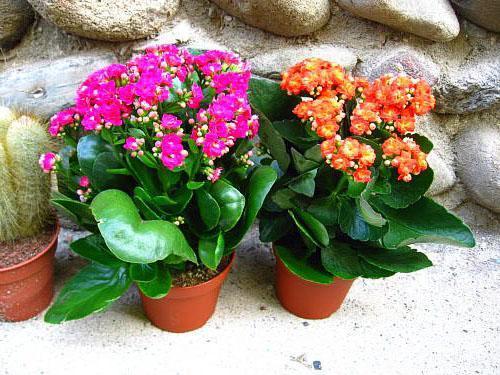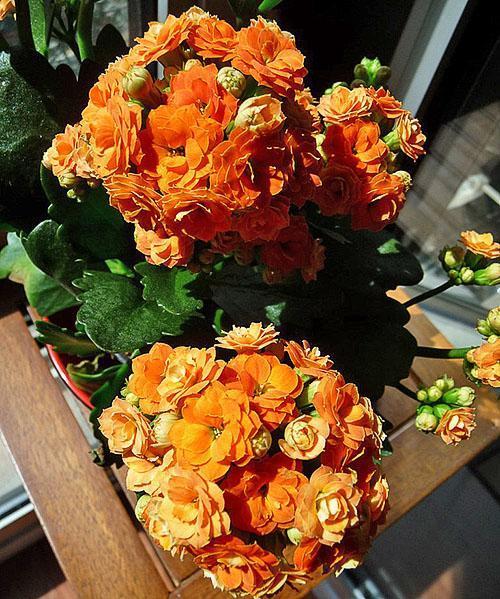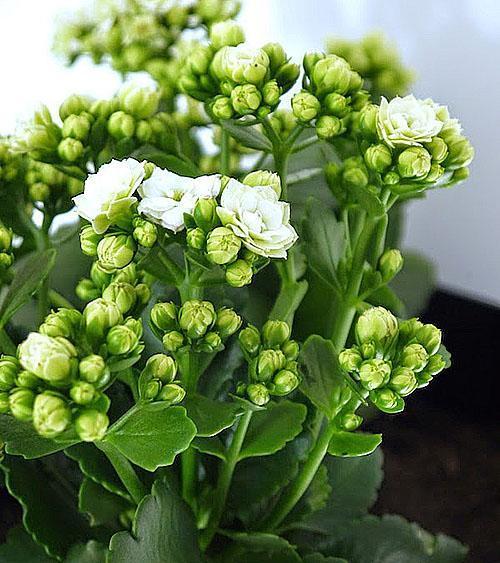Getting to know Kalanchoe Kalandiva
 Plants united by the genus Kalanchoe, in nature, are mostly found in the Southern Hemisphere. Kalanchoe Kalandiva is no exception, representing a miniature, luxuriantly blooming subspecies of Blossfeld's Kalanchoe.
Plants united by the genus Kalanchoe, in nature, are mostly found in the Southern Hemisphere. Kalanchoe Kalandiva is no exception, representing a miniature, luxuriantly blooming subspecies of Blossfeld's Kalanchoe.
Like other varieties, Kalanchoe Kalandiva is grown as a room crop and is deservedly considered an unpretentious plant, which even a novice grower can take care of.
Description of the features of Kalanchoe Kalandiva

In the store, small bushes of this type are sold under the name Kalanchoe Kalandiva mini, surprising with large leaves and lush inflorescences.
Indeed, a striking difference from outwardly similar species is that the flowering of Kalanchoe Kalandiva lasts about six months, and double flowers collected in racemose inflorescences up to a centimeter in diameter can be white, yellow, orange, pink and deep red. Having collected a mix of Kalanchoe Kalandiva of various colors on the windowsill, you can admire the bright inflorescences during winter and spring, the period when light and colors are most needed, and then the plant needs a short period of rest for growth and new strength.
With proper care, the Kalanchoe at home picks up buds in January, and the last flowers wither only by the beginning of summer.
 In addition, the plant grows quickly, is unpretentious and easily propagates in several simple ways. How to care for Kalanchoe Kalandiva so that an indoor flower pleases with lush flowering? What conditions for this culture need to be created for the long life and health of the plant at home?
In addition, the plant grows quickly, is unpretentious and easily propagates in several simple ways. How to care for Kalanchoe Kalandiva so that an indoor flower pleases with lush flowering? What conditions for this culture need to be created for the long life and health of the plant at home?
Conditions of detention and care of the Kalanchoe at home
 Like almost all succulents, Kalanchoe Kalandiva does not cause serious trouble for owners, with the exception of some care features, on which the plant's entry into the flowering time depends. And here the greatest role for flower culture is played by lighting arrangement.
Like almost all succulents, Kalanchoe Kalandiva does not cause serious trouble for owners, with the exception of some care features, on which the plant's entry into the flowering time depends. And here the greatest role for flower culture is played by lighting arrangement.
In nature, Kalanchoe grows in open areas where there is no lack of light, but direct rays cannot harm shoots, foliage and flowers.
Therefore, for a pot with a plant, it is optimal to choose a place on a windowsill facing east or west. If this is not possible, the northern windows will have to provide good illumination to the Kalanchoe, and the bushes on the southern windows. Kalanchoe Kalandiva blooms during the darkest period of the year. A plant, unlike many crops, does not need more than 9 hours of daylight, but backlighting in cloudy weather is simply necessary. Moreover, both the lack of light and its excess can lead to the "refusal" of the plant from laying buds.
Because of such a small mistake, many amateurs have the opinion that this is practically a "one-time" flower, and it will not be possible to achieve its re-flowering by taking care of the Kalanchoe at home.
 In fact, you just have to establish the proper lighting mode, provide the bush watering, a suitable temperature and feeding, as the Kalanchoe will surely please with lush double bouquets on the tops of the shoots. The special temperature regime of Kalanchoe Kalandiva is not required.In summer, the flower feels great indoors, on a terrace or veranda, where the air is heated to 18 to 28 ° C. Such unpretentiousness allows you to take out Kalanchoe pots into the garden and even organize seasonal gardening with their help.
In fact, you just have to establish the proper lighting mode, provide the bush watering, a suitable temperature and feeding, as the Kalanchoe will surely please with lush double bouquets on the tops of the shoots. The special temperature regime of Kalanchoe Kalandiva is not required.In summer, the flower feels great indoors, on a terrace or veranda, where the air is heated to 18 to 28 ° C. Such unpretentiousness allows you to take out Kalanchoe pots into the garden and even organize seasonal gardening with their help.
How to care for Kalanchoe so that the plant will delight with flowers? In autumn, when the plants are to form flower buds, the temperature for the Kalanchoe is lowered to 14–16 ° C. At this time, it is important to reduce the intensity of watering, since roots sensitive to excess moisture at low temperatures can rot:
- When watering in autumn, a barely noticeable wilting of leaves may become a sign of the need for watering.
- In other periods of the year it is better to focus on the condition of the soil under the plant. If the soil is dry a couple of centimeters, this should be a sign that Kalanchoe Kalandiva needs water.
 During the heating period, the plant can not be sprayed additionally, but you need to arrange a small shower for the foliage. This will have a beneficial effect on metabolic processes, chlorophyll synthesis and Kalanchoe growth.
During the heating period, the plant can not be sprayed additionally, but you need to arrange a small shower for the foliage. This will have a beneficial effect on metabolic processes, chlorophyll synthesis and Kalanchoe growth.
For the fast-growing and losing its compact form Kalanchoe Kalandiva, serious pruning of excessively lengthening shoots is extremely important.
Such a measure will not only return the appearance of the bush, but also awaken new points of growth, stimulate the appearance of more inflorescences.
 Sometimes the absence of flowers causes excessive care of the Kalanchoe at home, namely, excessive feeding of the plant with nitrogen, which causes active growth of greenery. When choosing a fertilizer mixture for this crop, it is better to be guided by the presence of phosphorus and potassium in the mixture. These elements are essential for long-term mass flowering Kalanchoe. As a ready-made product, you can pay attention to fertilizers for succulents and flower indoor plants.
Sometimes the absence of flowers causes excessive care of the Kalanchoe at home, namely, excessive feeding of the plant with nitrogen, which causes active growth of greenery. When choosing a fertilizer mixture for this crop, it is better to be guided by the presence of phosphorus and potassium in the mixture. These elements are essential for long-term mass flowering Kalanchoe. As a ready-made product, you can pay attention to fertilizers for succulents and flower indoor plants.
Plants are transplanted as needed, when the root system of the Kalanchoe entwines the entire earthen lump and requires an expansion of the "living space"
 During flowering, the roots practically do not grow, and any manipulations with the bush can lead to the loss of flowers and buds. Therefore, it is better to transplant Kalanchoe Kalandiva mini or another variety during the rest period, not more often than after 2-4 years. There are no special requirements for the soil for the Kalanchoe. The main quality of the soil is looseness and considerable lightness. You can take it as a ready-made mixture for succulents or flowering plants by adding a quarter of the volume of washed sand to the last soil.
During flowering, the roots practically do not grow, and any manipulations with the bush can lead to the loss of flowers and buds. Therefore, it is better to transplant Kalanchoe Kalandiva mini or another variety during the rest period, not more often than after 2-4 years. There are no special requirements for the soil for the Kalanchoe. The main quality of the soil is looseness and considerable lightness. You can take it as a ready-made mixture for succulents or flowering plants by adding a quarter of the volume of washed sand to the last soil.
 The easiest way to propagate Kalanchoe Kalandiva is by cuttings obtained when cutting an adult bush:
The easiest way to propagate Kalanchoe Kalandiva is by cuttings obtained when cutting an adult bush:
- Parts of the plant take root so easily that for this you can use not only a nutritious substrate, wet sand, but even ordinary water.
- Within a week, enough roots are formed to transplant the cuttings to a permanent place. In this case, the aerial roots on the shoot take on the role of ordinary ones.
- Kalanchoe will be ready for flowering with proper care at home in about six months.
 If you have patience, you can get young plants from individual Kalanchoe leaves. To do this, a leaf torn off with a petiole is slightly dried and rolled halfway into a suitable soil. After some time, tiny rosettes will appear on the grooves along the edge of the leaf, which, as they grow and the roots appear, can be separated and planted for growing.
If you have patience, you can get young plants from individual Kalanchoe leaves. To do this, a leaf torn off with a petiole is slightly dried and rolled halfway into a suitable soil. After some time, tiny rosettes will appear on the grooves along the edge of the leaf, which, as they grow and the roots appear, can be separated and planted for growing.
New bushes can also be grown from small seeds, sometimes ripening at home, but they may not meet the expectations of the grower, since the hybrid Kalanchoe Kalandiva mix sold in stores, in this case, do not retain parental features.